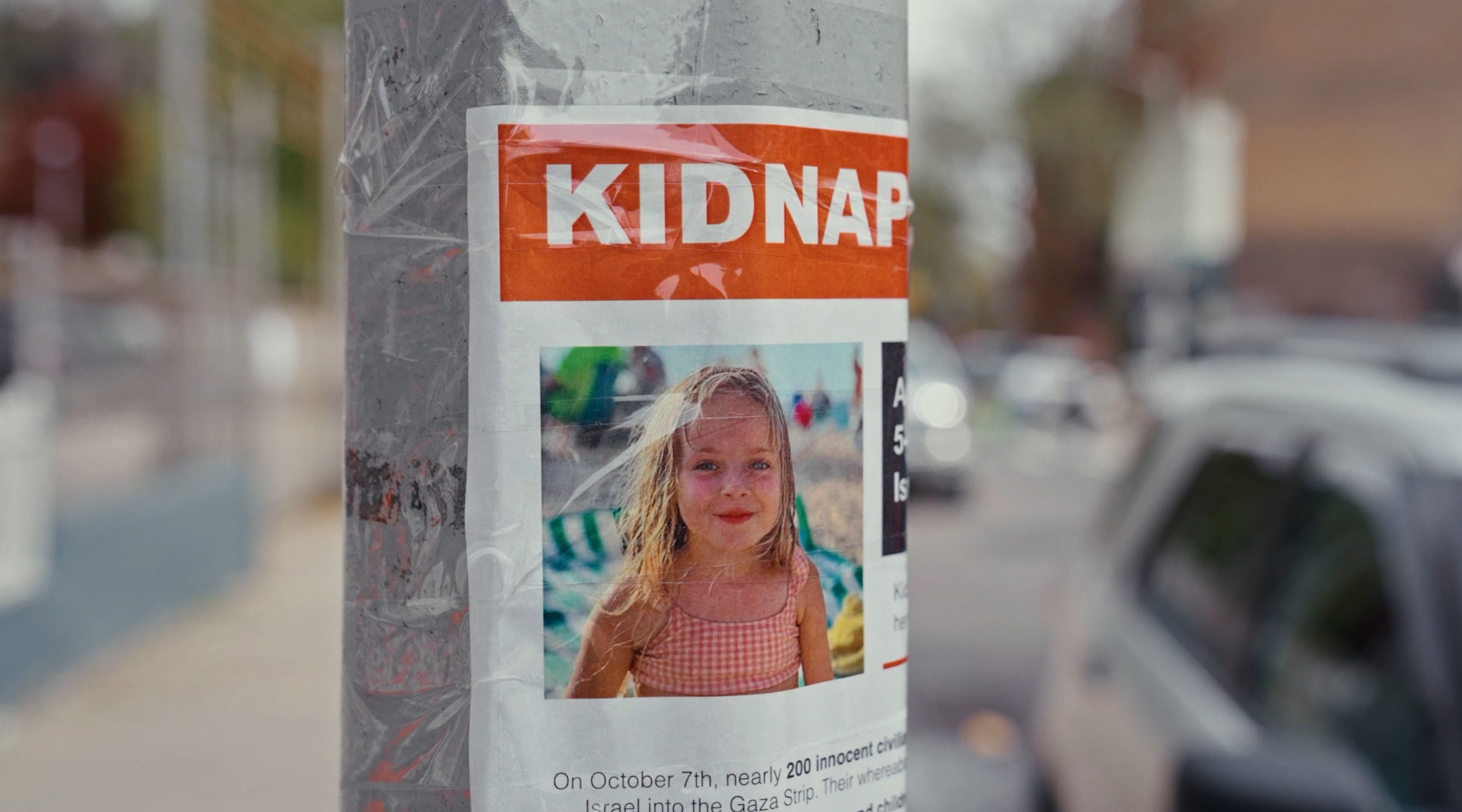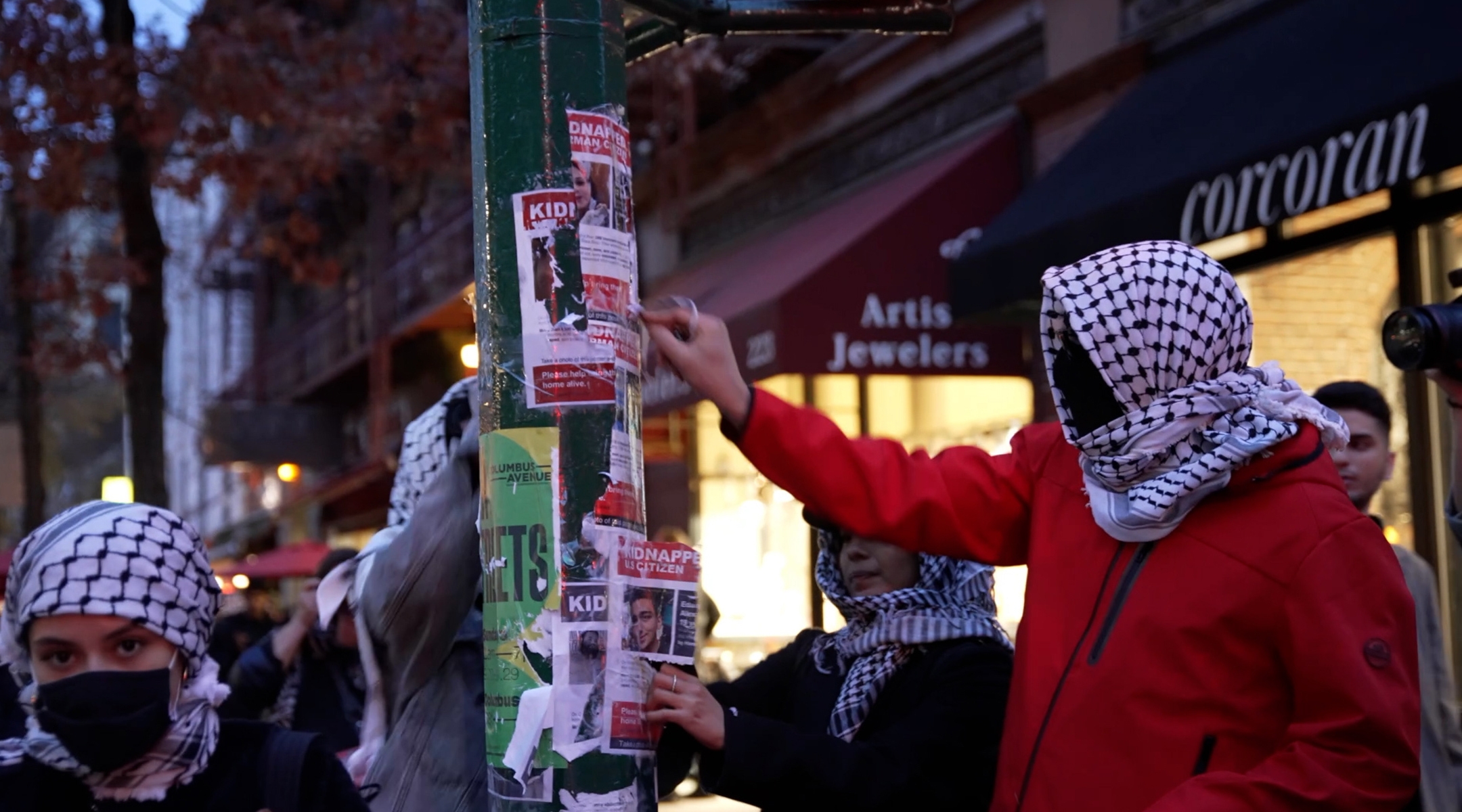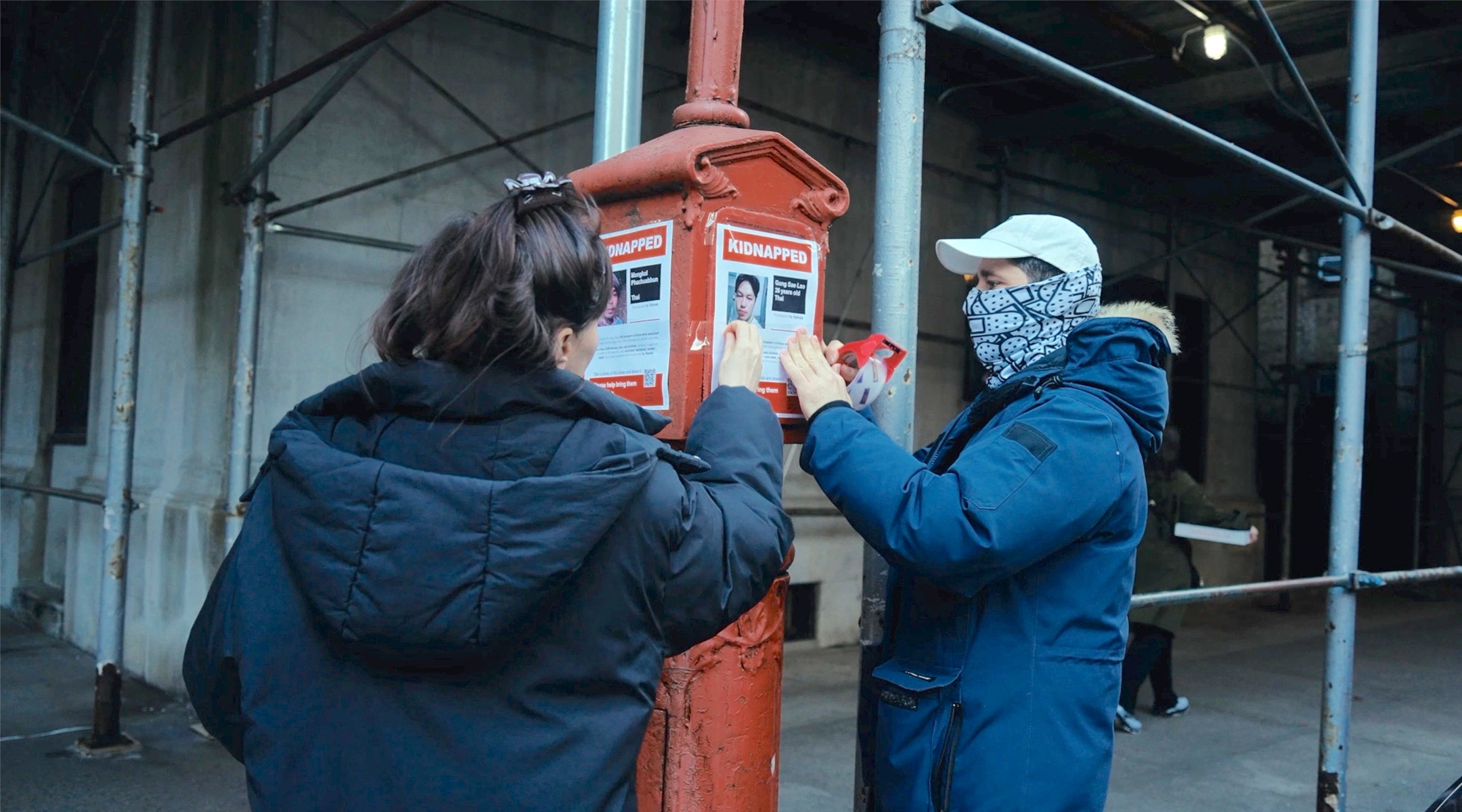Israeli-American filmmaker Nim Shapira was in his hometown of Tel Aviv celebrating Simchat Torah and his mother’s birthday on Oct. 7, 2023. That morning, he woke up to rockets, and watched the news in horror as the number of casualties and hostages rose.
It was a harrowing, life-changing experience. But it was how the ensuing conflict between Israel and Hamas played out in New York City, his home since 2013 — thousands of miles from the deadly war — that inspired his most recent film, “Torn.” The film focuses on “Kidnapped from Israel” posters that rapidly appeared around the city and across the globe in the days and weeks following Hamas’ attack, and how they became flashpoints in the culture war over the Israeli-Palestinian conflict.
When Shapira returned to New York in early November, he, like countless other New Yorkers, was drawn to the very public street campaign to raise awareness about the 240 hostages taken by Hamas. The “Kidnapped” posters appeared at innumerable venues across the city — subway stations, restaurants, politicians’ offices and much more. Just as quickly as they appeared, activists claiming to represent Palestinian voices would tear them down.
In the weeks following Oct. 7, the fast-spreading poster initiative provided an outlet for Jewish New Yorkers and other supporters of Israel who felt frustrated by their inability to aid the war effort, and were isolated by their distance from the fighting. At the same time, the posters became one more front in the battle for public opinion on the war. Many who tore down the posters berated the activists who put them up and launched a counter-campaign highlighting Palestinian losses.
The 75-minute “Torn” is playing at festivals and theaters around the country, including a forthcoming New York City screening at Temple Emanu-El’s Streicker Center on Dec. 12, followed by a screening at the Marlene Meyerson JCC Manhattan on Jan. 21. It explores the motivations of those who both put up and tore down the posters across the city.

Following Hamas’ Oct. 7, 2023 attack on Israel, “Kidnapped” posters featuring Israeli hostages rapidly began appearing around New York City and elsewhere. (Screenshot from “Torn”)
“It’s a campaign that works in both physical and online spaces,” Shapira, 42, said of the poster campaign following a screening of “Torn” at New York University in October. “I wanted the film to talk about symbols and what symbols mean to us. When you are thousands of miles away from the conflict, most people don’t have skin in the game, but still participate in tearing down the posters. I wanted to explore this.”
“In some way, people tearing down the posters made them go more viral,” added Shapira, who lives in Brooklyn and previously worked in advertising. “I wanted to look at the zeitgeist of what happened and have the film be an invitation for a conversation.”
Among the many subjects of the film are the creators of the poster campaign, Israeli artists Dede Bandaid and Nitzan Mintz, who happened to be in New York City on a three-month art residency when the war began.
“Our Facebook feed was flooded with posts from parents, desperately looking for their children and vice versa,” Mintz explains in the film. “We’re in New York, where life carries on as if it’s all normal.”
“We started brainstorming on what we can do,” Bandaid adds. “How to use our expertise to echo the voices of the hostages? It was clear to us that we must do something in the street to capture New Yorkers’ attention.”
Inspired by the missing children milk carton campaign of the 1980s, the married couple printed 2,000 flyers that showed a photo and provided some details about the hundreds of people who were taken from Israel that day. They began pasting them up all over the streets of New York and tried to enlist passersby to help, mostly to no avail.
Discouraged, the couple posted a DropBox folder with the fliers on social media and then collapsed into sleep. “When we woke up in the morning, our phones were just filled with photos and videos from people sharing what they were doing,” Bandaid told the New York Jewish Week last October. “The whole city was filled with posters.”
Also interviewed is prominent hostage advocate Alana Zeitchik, who was named to the New York Jewish Week’s 36 to Watch list this year. She and her brother, Liam, have six relatives among the hostages kidnapped by Hamas on Oct. 7.
“I started to spot these posters around and it helped me get through every day since Oct. 7,” Liam says in the film. “It meant the world to me to see that people cared.”
“The posters really did affect me,” Alana adds. “A lot of that had to do with seeing them ripped down and putting them up with my brother and hours later, seeing my baby cousins’ faces slashed or something else put into place saying, ‘Glory is the martyr.’ I couldn’t understand it.”
Julia Simon, a senior at Parsons School of Design, is friends with Omer Neutra, a New York native who was, until this week, believed to be a living hostage held by Hamas. (The Israeli military announced Dec. 2 that Neutra was killed during the Oct. 7 attack; his body is believed to be in Gaza.) In the film she, too, describes the pain of grieving for her friend while also seeing Neutra’s image torn down or defaced.
“On my commute to school I would see a picture of Omer on a kidnapped poster, but by the time I would get home it would be vandalized in the most brutal way,” she says. “It was either torn down, or spray painted, or there was something vile written over it. There was a level of anger and sadness that made me go numb.”
While Shapira endeavors to talk with and show empathy to those suffering on all sides of the war, he had little success interviewing people who tore down the posters. “I reached out to people from the other side, but all I heard were horrible things or they didn’t want to talk to me,” he said. “I wanted to have a genuine conversation.”

Almost as quickly as pro-Israel activists posted “Kidnapped by Hamas” posters around New York City, pro-Palestinian activists tore them down. (Screenshot from “Torn”)
Instead, the film relies upon TV news footage and social media posts to hear from individuals who were opposed to the poster campaign. The footage shows individuals ripping down or defacing hostage posters, who are then asked why they are doing it and if they would like to share their name. Responses vary from smiling and laughing, to giving the middle finger, to a variety of expletives. Those who engaged on video provided answers like, “Go colonize somewhere else,” “Your posters are propaganda” or“Let’s put up the 3,000 kidnapped kids in Gaza.”
“A week after the war started, people made up their minds about the war,” said Shapira, who is also gay and a vegan. “I was putting up posts on Instagram about the war and people are responding that the hostages are actors or AI manipulations. These were people that were friends of mine and made me feel unwelcome in our shared communities.”
“The film shows pain on all sides, and the thesis is to have a conversation,” Benjamin Meppen, a junior in the NYU Tisch School of the Arts’ film program, told the New York Jewish Week after the October screening.
Shapira agrees with the student’s description. “This film is not for Jews — this film is for New Yorkers, it’s for Americans,” he said. “My hope is that it’s an invitation to talk about compassion and why compassion is lacking.”
The New York Jewish Week brings you the stories behind the headlines, keeping you connected to Jewish life in New York. Help sustain the reporting you trust by donating today.





